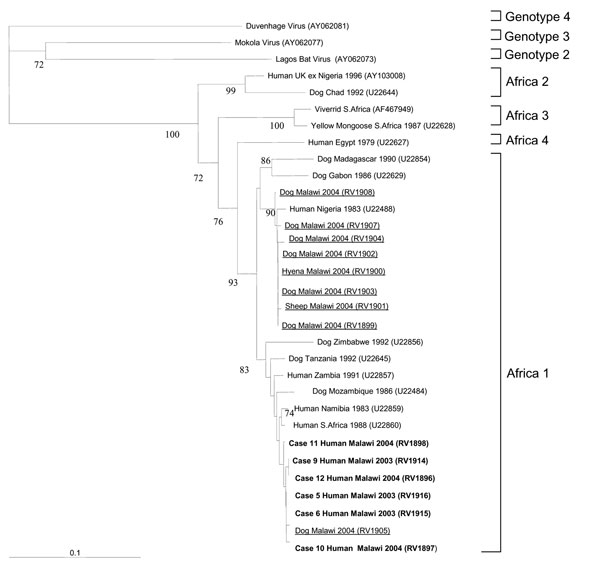Volume 13, Number 1—January 2007
Dispatch
Rabies Encephalitis in Malaria-Endemic Area, Malawi, Africa
Figure

Figure. Phylogenetic tree, based on 400 nucleotides of the nucleoprotein gene (10), showing the relationship between rabies virus isolates in this study from humans (in boldface) and animals (underlined), and other representative isolates; GenBank accession nos. are in brackets. Bootstrap values >70% are considered significant and are included within the figure. The Africa 1, 2, 3, and 4 genotypes are within rabies virus genotype 1 (13).
References
- Fooks A. The challenge of new and emerging lyssaviruses.Expert Rev Vaccines. 2004;3:333–6. DOIPubMedGoogle Scholar
- Rupprecht CE, Hanlon CA, Hemachudha T. Rabies re-examined.Lancet Infect Dis. 2002;2:327–43. DOIPubMedGoogle Scholar
- Warrell MJ, Warrell DA. Rabies and other lyssavirus diseases.Lancet. 2004;363:959–69. DOIPubMedGoogle Scholar
- World Health Organization. Management of severe malaria. Geneva: The Organization; 2000.
- Solomon T, Dung NM, Vaughn DW, Kneen R, Thao LTT, Raengsakulrach B, Neurological manifestations of dengue infection.Lancet. 2000;355:1053–9. DOIPubMedGoogle Scholar
- Molyneux ME, Taylor TE, Wirima JJ, Borgstein A. Clinical features and prognostic indicators in paediatric cerebral malaria: a study of 131 comatose Malawian children.QJM. 1989;71:441–59.PubMedGoogle Scholar
- Verity CM, Butler NR, Golding J. Febrile convulsions in a national cohort followed up from birth. I. Prevalence and recurrence in the first five years of life.BMJ. 1985;290:1307–10.PubMedGoogle Scholar
- Dean DJ, Abelseth MK, Atanasiu P. The fluorescent antibody test. In: Meslin F-X, Kaplan MM, Koprowski H, editors. Laboratory techniques in rabies. 4th ed. Geneva: World Health Organization; 1996. p. 88–95.
- Johnson N, Black C, Smith J, Un H, McElhinney LM, Aylan O, Rabies emergence among foxes in Turkey.J Wildl Dis. 2003;39:262–70.PubMedGoogle Scholar
- Heaton PR, Johnstone P, McElhinney LM, Cowley R, O’Sullivan E, Whitby JE. Heminested PCR assay for detection of six genotypes of rabies and rabies-related viruses.J Clin Microbiol. 1997;35:2762–6.PubMedGoogle Scholar
- Hommel M. Diagnostic methods in malaria. In: Warrell DA, Gilles HM, editors. Essential malariology. 4th ed. London: Edward Arnold; 2002. p. 35–56.
- Johnson N, Lipscomb DW, Stott R, Gopal Rao G, Mansfield K, Smith J, Investigation of a human case of rabies in the United Kingdom.J Clin Virol. 2002;25:351–6. DOIPubMedGoogle Scholar
- Kissi B, Tordo N, Bourhy H. Genetic polymorphism in the rabies virus nucleoprotein gene.Virology. 1995;209:526–37. DOIPubMedGoogle Scholar
- Olumese PE, Gbadegesin RA, Adeyemo AA, Brown B, Walker A. Neurological features of cerebral malaria in Nigerian children.Ann Trop Paediatr. 1999;19:321–5. DOIPubMedGoogle Scholar
- Cleaveland S, Fevre EM, Kaare M, Coleman PG. Estimating human rabies mortality in the United Republic of Tanzania from dog bite injuries.Bull World Health Organ. 2002;80:304–10.PubMedGoogle Scholar
Page created: June 28, 2010
Page updated: June 28, 2010
Page reviewed: June 28, 2010
The conclusions, findings, and opinions expressed by authors contributing to this journal do not necessarily reflect the official position of the U.S. Department of Health and Human Services, the Public Health Service, the Centers for Disease Control and Prevention, or the authors' affiliated institutions. Use of trade names is for identification only and does not imply endorsement by any of the groups named above.